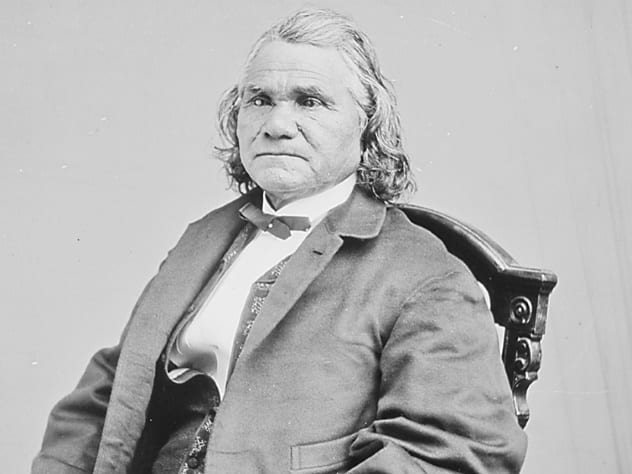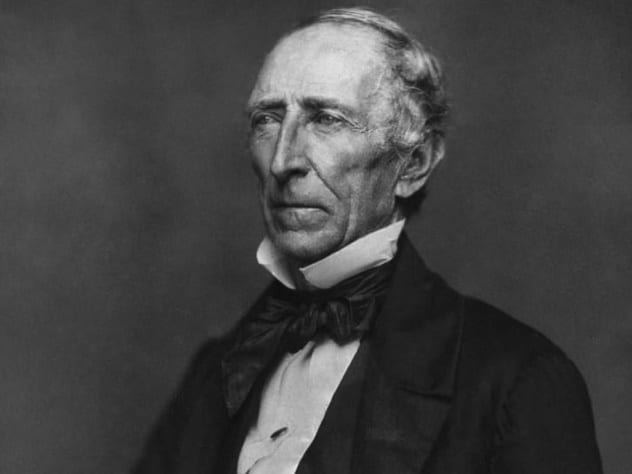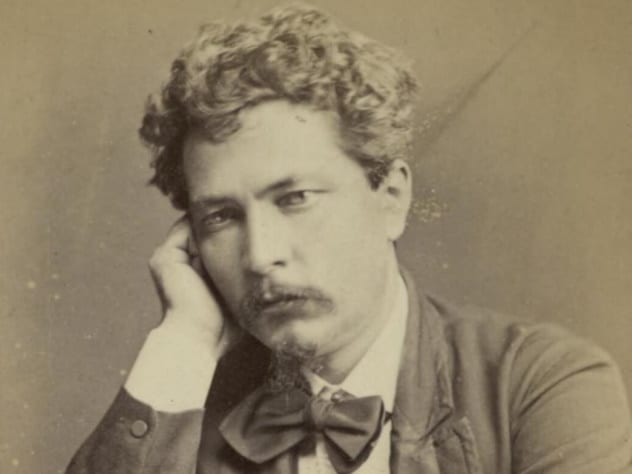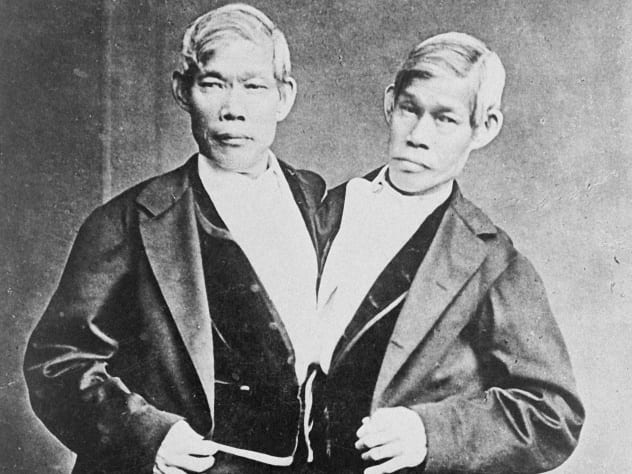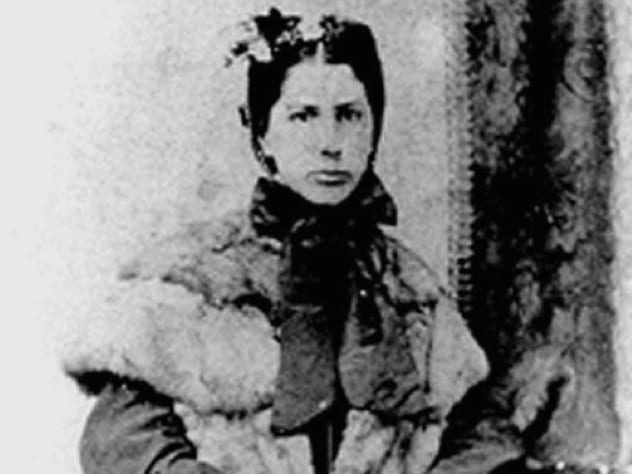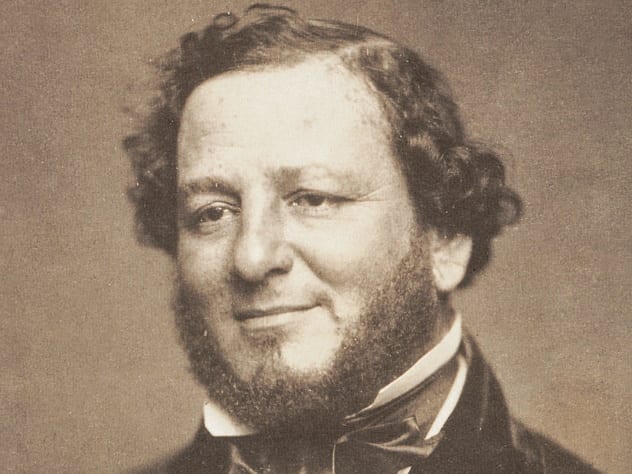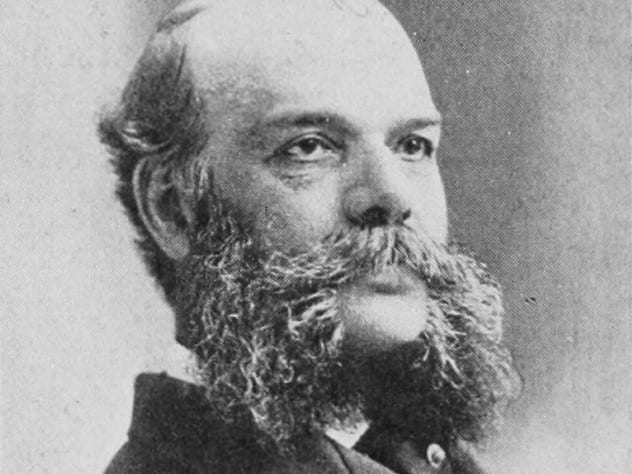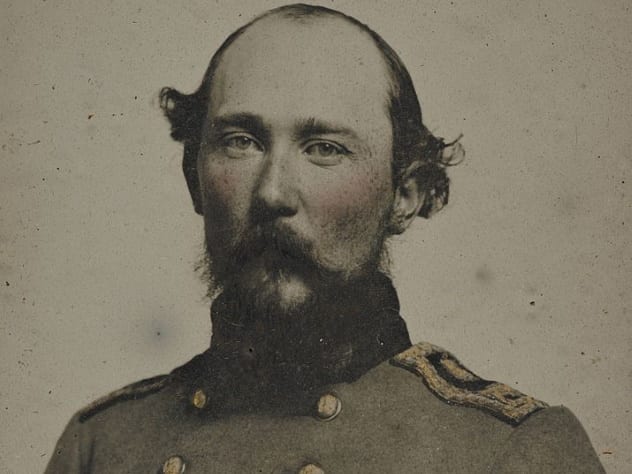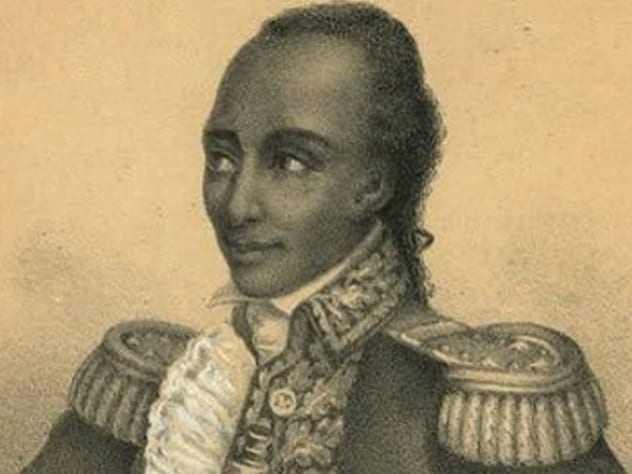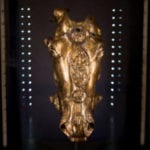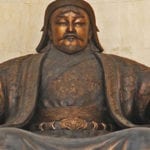It is true that the Confederacy would not have come into its brief existence without widespread white support for racialized slavery, which its own vice president called the cornerstone of the rebellion. Yet these broad strokes paint over finer detail. The truth is, as always, more complicated. There are shades of gray among those who wore it. People like . . .
10 A Cherokee Chief
For a region whose destiny was bound up with the institution of black slavery, it’s easy to tag the Confederacy as a simple conglomerate of white supremacists. And there were plenty of those. But it must also be recognized that not all Confederates—not even all Confederate slaveowners—were white. State authorities in the South had a long history of dealing with the Native American groups, known collectively at the time as the Five Civilized Tribes: the Cherokee, Chickasaw, Choctaw, Muscogee, and Seminole. They received the title because they had adopted many aspects of white culture, including written language, centralized governments . . . and black chattel slavery. When the Cherokee marched west on the Trail of Tears, they drove African American slaves before them. When war came in 1861, the outnumbered Confederates were willing to negotiate on equal terms with the tribes in exchange for support, and many of them (including high numbers of Cherokee and Choctaw) agreed. The tribes furnished thousands of men for the Confederate cause, many fighting to maintain the same slaveholding autonomy as their white compatriots. The most famous of these men—the only one who would become a Confederate general—was Stand Watie. A divisive political figure among the Cherokee dating back to the days of their relocation/removal to the Indian Territory, Watie maintained a successful plantation in Honey Creek, Oklahoma. By 1861, he’d become an ardent supporter of the Confederacy, believing that Cherokee rights would be best safeguarded within it. The tribe split into northern and southern factions, which warred with each other across the territory (modern-day Oklahoma). During the conflict, Watie was elected as principal chief of the southern faction. In addition to this civil war within a civil war, Watie led Native American troops in combined operations with other Confederate forces, most notably at the Battle of Pea Ridge and the Second Battle of Cabin Creek. He even pulled off an ambush on a Union supply steamer on the Arkansas River, later amiably referred to as the only naval battle in Oklahoma history. Promoted to command of an entire brigade of Native American soldiers, Watie received a general’s commission to match. He even rose to divisional command in early 1865, by which time the “Lost Cause” had truly become lost. Nonetheless, he kept his force in fighting shape and did not sign a cease-fire until late June of that year, more than a month after most other Confederate units. At that time, this most atypical Southern general was the last one still in the field.[1]
9 A Former US President
It’s also an easy oversimplification to view the Southern rebellion as a rejection of the entire concept of the United States—after all, the Confederates proclaimed they were leaving said country and forming a new one. But these rebels saw themselves as preserving the purest form of the American republic, rather than repudiating it. The Confederate constitution was modeled on the US version, and the first Confederate national flag was obviously inspired by the Stars and Stripes. Only with this understanding is it possible to make sense of the record of John Tyler—the man who both led the Union and seceded from it. Tyler succeeded to the presidency after the death of blink-and-you’ll-miss-him President William Henry Harrison. Aside from the confident way in which he assumed the office, which became the model for American vice presidential successions, Tyler did not achieve much lasting impact during his time in office. He ended his term out of favor with both political parties. Tyler mostly stayed out of political life in later years, until politics invaded his life (and everyone else’s) in the form of the secession crisis. Then Tyler lent his considerable weight as a president-emeritus to averting the looming conflict. He helped organize the Peace Conference, a last-ditch effort to mend the North-South split through dialogue. Elder statesmen from more than 20 states—derisively dubbed the “Old Gentlemen” by some—met in early 1861 and worked feverishly to author a compromise that would placate both sides. Tyler served as its president, even as his granddaughter was helping to open the Confederate constitutional convention in Alabama. The Peace Conference was a forlorn hope, however. Tyler disagreed with the compromise produced, believing it unworkable, and voted against the final measure. He departed for the Virginia secession convention soon after and threw in his lot with the secessionists. They were glad to have him, appreciating the legitimacy he gave to their cause. Virginians elected him to represent them at the Confederate Congress, an office he held when he died, just a year after the Peace Conference. Tyler’s symbolic usefulness continued in death. He had wanted a simple burial, but Confederate president Jefferson Davis proclaimed it a grand affair. Huge crowds trooped to the Confederacy’s premier cemetery in Richmond to watch Tyler be laid to rest under a tall obelisk, lauded as what one biographer called “a Confederate caricature of the real man.” He remains there today, the only American president not granted US honors at his funeral—since he was buried under a Confederate flag, not a Union one.[2]
8 A Future Renowned (And Controversial) Explorer
Like any armed conflict, the US Civil War drew a lot of young men into its maelstrom; it is perhaps inevitable that a certain proportion of the survivors would go on to do something noteworthy in later life. So it was with Henry Morton Stanley, who would later make a name for himself during the European scramble for Africa. The Welsh Stanley (born John Rowlands) had led a hard-knock life from his earliest days. Born out of wedlock to two parents who wanted nothing to do with him, as a child he drifted between uninterested or destitute family members, eventually enduring a Dickensian childhood in a rough and violent workhouse. America’s scent of opportunity smelled good to him, and he immigrated to New Orleans at age 16. Life was somewhat better for him in America; he moved to Arkansas, changed his name, gained employment as a shopkeeper, and even began courting a local young woman. But Stanley had run from his European problems only to run smack into American ones; war broke out less than two years after his arrival. The young man had no interest in the fight, but everyone else did. He soon found that he was the only youth in town who had not enlisted in the midst of patriotic fervor. He was denounced for cowardice, with the matter brought to a head by someone depositing a package on his doorstep containing women’s undergarments, with the obvious implication that he was not performing his manly duty by joining up. Shamed, he enlisted soon afterward—and eventually found himself marching with the 6th Arkansas Infantry toward the bloody Battle of Shiloh. His Southern service was brief. After participating in the Confederate surprise attack on the first day of the battle—and finding war much more horrible and much less glorious than advertised—Stanley was captured on the second. Shipped off to a Union prison camp in Illinois, he suffered its privations (rampant disease and overcrowding) before answering a call from prison authorities recruiting for Union service. He had no great love for the South and was eager to get out of the conditions in which he found himself. This made him one of several thousand former Confederates who accepted the same offer, known later as “Galvanized Yankees.” The North didn’t get much good service out of him, either. Shipped east, he fell ill with dysentery before arriving at the battlefront and eventually deserted from the hospital. After a side trip to back home to Wales, in which he found his mother still dismissive of him, he returned to America by way of New York. He enlisted again, this time in the Union Navy. His tenure lasted for a few months of boring blockade duty, following which he deserted again.[3] Later life was a bit kinder to him. After finding some success as a roving journalist, he was tasked with a major story: discovering the fate of famed explorer David Livingstone, long lost in the heart of Africa. This grueling but successful expedition—punctuated by the famous phrase “Dr. Livingstone, I presume?”—marked Stanley’s transition into an energetic explorer and advocate for European interests in Africa. History does not record whether Stanley discussed the Civil War with Livingstone, whose own son Robert fought for the Union and had died in a Confederate prison camp. Stanley is best remembered today for his explorations (a mixed bag of success and failure), for which he was recognized late in life with a British knighthood. But he could also claim one more footnote for his record: He was perhaps the only man to serve in both armies and one navy on opposing sides of the American conflict.
7 A Prussian Aristocrat
Henry Stanley was far from the only non-American involved in the war. Even casual students of the US Civil War know the major stories behind foreigners in the ranks. Immigrants played an outsize role in the conflict, especially on the Union side, with whole units (like the Irish Brigade or majority-German XI Corps) characterized by their non-native status. But there were also foreign combatants who had no intention of immigrating. These were the military adventurers, soldiers of fortune who simply turned up wherever there was an interesting war being waged. Quite a few of them fought in the war, on both sides, but arguably the most swashbuckling one of all was a huge Prussian named Heros von Borcke. He perfectly embodied the stereotype of the cash-strapped nobleman looking for fresh success. While serving as a debt-ridden lieutenant in the Prussian cavalry in 1861, von Borcke heard of the outbreak of the American war. Deciding that the conflict sounded preferable to his current situation, von Borcke left his unit and sailed east, slipping through the Union blockade to join Confederate forces in 1862. Upon arrival, von Borcke attached himself to the entourage of cavalry commander Jeb Stuart. Stuart was impressed with what he saw: Von Borcke stood 193 centimeters (6’4″), equal to Abraham Lincoln, and weighed 109 kilograms (240 lb). He also carried a gigantic German broadsword, which he chose to wield instead of the relatively lightweight sabers carried by most military men of the time. Stuart’s thirst for dashing exploits matched von Borcke’s own. While some staff postings meant a cushy rear-area assignment, Stuart’s staff members got precisely the opposite. They followed their hard-riding commander into many a tight spot, and von Borcke reveled in it. He was there for many of Stuart’s famous deeds, including a cavalry ride around the Union army in 1862 and the desperate fight at Brandy Station in 1863. In every action, he hefted his sword and pistols, winning acclaim from his compatriots and inspiring fear in his opponents. More than one Northerner was relieved when von Borcke was taken out of action by a serious wound in June 1863. The Prussian would eventually return to service, only to see his chosen cause flame out in early 1865.[4] Though he soon returned to Europe, where he once again served the king of Prussia in warfare, von Borcke’s relatively brief Civil War service dominated the rest of his life. His inherited castle in Giesenbrugge, Prussia, (now Poland) was probably the only one in European history to fly the Confederate flag. One Union bullet stayed in him, causing lifelong complications that ended only with his death from sepsis in 1895. He was survived by a daughter—Karoline Virginia, named after the state where he spent most of his American adventure—and a set of popular memoirs detailing his service. Von Borcke’s headstone in Giesenbrugge was destroyed by the Soviets during World War II, but a subsequent campaign by the Sons of Confederate Veterans organization set out to raise funds for a replacement. In return for von Borcke’s own transatlantic trip long before, the SCV sent the money to Europe in 2008, where it was used to erect the Prussian giant’s current memorial.
6 The Original ‘Siamese Twins’
The chances of finding a person of Asian descent in the mid-19th century United States were rather small; the chances of finding one on the East Coast were vanishingly small. The chances of finding one as a prominent local citizen in a Southern state on the eve of the Civil War would be one in a million. Rather, make that two in a million, for there were two of them: Chang and Eng Bunker, the most celebrated pair of conjoined twins in history. Before they settled down in Mount Airy, North Carolina, the brothers had already lived a whirlwind life. Born in 1811 in the country of Siam (now Thailand), they were connected at the sternum by a ligament of flesh 13 centimeters (5 in) long, through which their livers were joined. This birth defect would dramatically shape their lives. They were transported from Siam in their late teens by an American businessman eager to make a fortune as their manager. They toured nationally and internationally, drawing crowds come to see them dance, perform gymnastics, or simply discuss their highly unusual lifestyle. They later tired of show business, though, and decided to settle down. They took a surname, Bunker, from a New Yorker they admired. They took wives: the Yates sisters, Sarah and Adelaide, of North Carolina. And they bought property: 650 acres of land, farm machinery, and 18 slaves as a labor force. Chang and Eng’s nonchalance about slavery is easy to understand; the practice was firmly established in their home country (and, arguably, remains so). What’s more striking is their acceptance into the surrounding white community, where they lived as local gentry, accommodated by neighbors and active in civic life. This reveals another complexity of the antebellum South: Assumptions and behaviors surrounding race could be suspended for the sake of personal familiarity. When Chang and Eng, black “mammies,” or Louisiana Creoles were accepted by whites, they were not accepted as members of a race entitled to acceptance because of that race. They were accepted in spite of it, as individuals. It was as individuals, then, that the Bunkers approached the war, and like so many other Southerners, they chose the defense of home and community over abstract principles. They supported the Confederacy with money, foodstuffs, and blood—for they each sent a son to serve in gray. The eldest Bunker sons, Christopher and Stephen—cousins to one another, though being as close as brothers in practice—crossed the border into Virginia to enlist as soon as they were old enough. Both skillful riders, they joined the 37th Virginia Cavalry and fought with it for many months. They were both present with the regiment at Chambersburg, Pennsylvania, where Confederates famously burned the town, but were separated afterward; Christopher was captured and suffered numerous privations in a Union prison camp in Ohio, while Stephen was later wounded in fighting at the Battle of Winchester.[5] Both cavalrymen would survive the war, as did their famous fathers. That said, Chang and Eng’s previous prosperity was ruined by the conflict, with properties damaged, investments defunct, and (of course) all slaves emancipated. To rebuild family fortunes, they returned to touring, which proved a successful business for another decade. The famous twins died within hours of each other in 1874, but their memory lived on through their veteran sons, as well as their many other children. Their pedigree remains today, with more than 1,500 Bunker descendants still gathering annually for a grand reunion back in Mount Airy.
5 Nancy Morgan And The Nancy Harts
Direct female participation in the American military has been a gradual thing. Even the few women who served in Civil War frontline units had to do so by concealing their sex. Certainly the antebellum South, which so often placed women on a pedestal, is the last place you’d expect to see such a progressive sight as an all-female unit in a combat role. But desperate times call for desperate measures, and a manpower-starved Confederacy couldn’t always be so choosy. So it was that the Nancy Harts came about—America’s first all-woman rifle company. Named after a Revolutionary War heroine, the unit arose in the Western Georgia town of LaGrange at the outbreak of the war. Like Henry Stanley’s town, LaGrange sent all its able-bodied men off to fight, leaving the remaining residents concerned about local defense. Mrs. Nancy Morgan of LaGrange spoke with her friends about the need for the remaining LeGrangers to defend themselves. Spirited local women soon responded by forming their own company, arming themselves with available weapons, and seeking training from a disabled local man who had stayed behind. They elected Mrs. Morgan as captain. The Nancy Harts were not the only female militia formed in the South during the war years, but they were the only ones to maintain their cohesion for more than a few months. For years, the women drilled, practicing marching and marksmanship. They kept it up even as they kept the rest of the town running: operating businesses, tilling fields, and raising families. As their captain remembered: The Nancy Harts did not have uniforms, as all the gray cloth and brass buttons available were bestowed upon their fathers and brothers; but in feminine dress of ruffled skirts and flowered or feathered hats, their hearts beat in unison to the captain’s command as they boldly marched [ . . . ] their reputation as expert marks-woman [became] widespread . . .[6] A critical moment arrived in April 1865, the twilight of the Confederacy. Word came that Union cavalry was approaching LaGrange, and no regular Confederate units were in place to stop them. It was the day the Nancy Harts had prepared for. The 30 women slung cartridge boxes over their dresses, hiked up their petticoats, and assembled in the town square, from which they marched to the edge of town to confront the enemy. Ironically, the Union officer approaching the town was also named LaGrange, and he pulled up short when faced with the most unique battle line ever presented during the four-year conflict. He had enough troops to overwhelm the women, certainly, but their show of determination gave him pause. Instead, he met with Captain Morgan, who negotiated the surrender of the town on honorable terms. Colonel LaGrange spared much of the town from the torch, and in gratitude, one of the Nancy Harts hung up her rifle long enough to cook dinner for him and his staff. Though they had never fired a shot in anger, the Nancy Harts had proved their mettle nonetheless.
4 The First Jewish Cabinet-Level Official In North America
Jews have been a frequently persecuted minority for millennia. They were barred from certain trades in colonial America, and no less a figure than Union general Ulysses Grant once issued an order expelling all Jews from his military district as nefarious troublemakers. Yet the South, hardly a progressive bastion, nevertheless possessed the first government in North America to elevate a Jew to a cabinet-level position. Or, rather, to three of them. Born in Louisiana to immigrant parents, young Judah Benjamin displayed a genius intellect from an early age. It soon propelled him to the top of the legal profession, and from there to the US Senate. While in office, he saw fit to issue a duel challenge to the current secretary of war, Jefferson Davis, for an insult. Davis apologized, and the duel never took place. Neither man expected that they would be bosom friends in a few short years. After secession, Davis was elected president of the Confederacy, and he selected Benjamin for his cabinet—as attorney general, in recognition of the man’s legal expertise. It was a waste of his talents, however; the Confederacy had no national court system for him to administer. Yet, despite their earlier quarrel, Davis increasingly came to rely on the Louisianan as a confidante and ally. He nominated Benjamin to the recently vacated post of secretary of war, where Benjamin would serve for a few months until outcry over Southern military reverses forced him out. Still, his place in the Davis cabinet was assured. The president named him to the office of secretary of state, where he would remain for three more years. The resolute Benjamin stayed by Davis’s side, even after most Confederate forces surrendered, until he narrowly avoided capture in South Carolina. (Davis wasn’t so lucky.) Finally completing his exodus in England, Benjamin found fresh success as a barrister there in the remaining decades of his life.[7] An enigma in many respects, Benjamin represents another case where Southern judgment made an exception. Any distaste for his immigrant, Semitic status was submerged in respect for his success and socioeconomic stature. (Having made his fortune before the war, he purchased a Louisiana plantation and the slaves to go with it.) Anti-Semitism, like other biases, often stems from Jews’ presence as a minority whom it is convenient to blame for societal ills—and anti-Semitism in the South may have been less due to the presence of a larger minority to blame: slaves and free blacks. Acceptance did not translate into huge popularity for Benjamin; many wartime Southern newspapers took to disgustedly calling him “Davis’ pet Jew.” Nor does it help explain Benjamin’s mysterious character—the man had once spoke in a courtroom on behalf of slaves’ humanity, yet he owned them himself. Benjamin burned his personal papers at the end of his life, making it extremely hard for later historians to truly understand him. Regardless, his place as a singular figure in the Confederacy is already assured.
3 Teddy Roosevelt’s Uncle
Future American president and icon Theodore Roosevelt was only three years old when the Civil War broke out; his own military adventures would have to wait until the country’s next major war. But his family, like so many others, was split by the conflict. Roosevelt’s father, a New Yorker, actively supported the Union; his mother was raised in Georgia, and several of her family members fought for the South. But it was Teddy’s uncle, James D. Bulloch, who gave the most significant support to the Confederate cause: He was a Southern spymaster. The blockaded South depended heavily upon sympathizers in Europe, who could be found in great numbers despite European nations’ official neutrality. Surreptitious networks crisscrossed the Continent, buying supplies, commissioning shipbuilding, and gathering information on US foreign interests. James Bulloch managed it all. One of his major feats was negotiating with a British firm to buy and sell Southern cotton smuggled out through the blockade, bankrolling many of the Confederacy’s efforts as a result. He also arranged for the construction of several of the South’s most notorious commerce raiding ships, including the CSS Alabama. Bulloch enabled Southerners to fight on in a singular fashion; without his efforts, the Confederacy might have collapsed far sooner than it did.[8] Bulloch never returned to his beloved South. When the war ended, he remained a fugitive in Europe for the rest of his life, albeit a comfortable one. He continued as a cotton broker, taking time out to heed his excitable nephew’s urgings to write memoirs about his spy service and to teach the young Roosevelt the finer points of naval warfare. Decades later, Roosevelt saw value in referencing his shared Union and Confederate heritage, emphasizing the virtues he saw displayed by each side rather than focusing on the detailed nature of their respective causes. He discussed his uncle’s Civil War record prominently in at least one speech, going on to say: It has been my very great good fortune to have the right to claim my blood is half southern and half northern, and I would deny the right of any man here to feel a greater pride in the deeds of every southerner than I feel. [ . . . ] All Americans who are worthy of the name feel an equal pride in the valor of those who fought on one side or the other, provided only that each did with all his strength and soul and mind his duty as it was given to him to see his duty.
2 Abraham Lincoln’s Brother-In-Law
The US Civil War is often nicknamed the Brothers’ War, with the broken bonds of brotherly love symbolizing the division of the country. Yet in some cases, the brotherly bonds were literal, and personal. This was particularly true in the border states, those on the line between North and South that had many sympathizers on both sides. Abraham Lincoln and his wife Mary (nee Todd) both had family ties in Kentucky, one such state. This led to some uncomfortable contradictions, such as when several of Mary’s brothers went to war for the South. Most dramatic was the case of Benjamin Hardin Helm, who had married Mary’s sister Emilie in the 1850s. When war came, Lincoln personally offered Helm a position as chief paymaster of the US Army, and Helm considered it. Yet like so many others, he eventually decided his loyalties lay with the South. He soon rose to command a whole brigade of Confederate Kentuckians, whom he led into the slaughter of the Battle of Chickamauga. Helm died there, in September 1863. Lincoln wept at the news. Still more paradoxical was the aftermath. Mary, being very close to Emilie, invited the widow and her three children to come for an extended visit. They passed through Union lines—and the president of the United States had an enemy general’s family as houseguests. The press had a field day. Amazingly, civility was largely maintained within the walls of the White House. The Lincolns tried to keep the focus on shared grief for mutual losses, and Emilie Hardin expressed gratitude for the Lincolns’ comfort. As she wrote in her diary: “Mr. Lincoln and my sister met me with the warmest affection, we were all too grief-stricken at first for speech. I have lost my husband, they have lost their fine little son Willie and Mary and I have lost three brothers in the Confederate service. We could only embrace each other in silence and tears.” When Lincoln found his son and one of the Helm children quarreling about who was president (Lincoln or Jefferson Davis), he did not take sides. He only defused the argument thus: “Well, Tad, you know who is your President, and I am your little cousin’s Uncle Lincoln.”[9] After the war, precious few Southerners were willing to simultaneously defend the Confederate record and Abraham Lincoln’s personal legacy. But Emilie Todd Helm was one of them.
1 The Biggest African American Slaveowner In South Carolina
To some of us, it seems utterly incredible to imagine a man who had lifted himself up from slavery perpetuating the practice by purchasing his own slave laborers, let alone supporting the society that maintained that bondage. Yet William Ellison did so, because he approached the question as a matter of livelihood. Born April Ellison circa 1790, the man was likely the son of white planter William Ellison and one of his female slaves. Such exploitative unions were depressingly common. The son, however, bucked the trend for such offspring by seizing legitimacy for himself. He saved money to buy his freedom and, upon doing so, took the name William Ellison Junior, blatantly laying bare his true paternity and putting it to work in his favor. Ellison’s self-starting nature continued to bear fruit. Using the skills he learned while a slave, he built up a thriving business manufacturing cotton gins—the machines credited with revitalizing the prewar Southern economy and cementing slavery as the indispensable institution of the region. Of course, entrepreneurial dreams in the South usually involved slaves, and Ellison’s enterprise was no exception. By 1860, in addition to his manufacturing business, he owned three small cotton plantations, with a land total of more than 1,000 acres and 53 slaves to work it all.[10] Fascinatingly, Ellison’s economic success seems to have negated many of his social disadvantages, similar to the Bunker brothers. He and his family were able to thrive in South Carolina, even becoming the first free family of color to install a family bench in the local Episcopal church, in a time when blacks were usually relegated to the upper galleries of worship spaces. Ellison had reached the higher rungs of Southern life, adopting the practices associated with that life—and the beliefs that went with it. When war thundered onto the scene in spring 1861, Ellison apparently didn’t hesitate. He offered his slaves’ service in support of the Confederacy and switched his cotton plantations to food crops that would feed the Confederate armies. His sons followed his example, even trying to enlist to fight on the South’s behalf—but they were turned away because of their race. That proved that there were limits to the Ellisons’ acceptance. William Ellison Jr. died in December 1861, long before the ruin of the Confederacy and the ruin of his family’s fortune that went with it. With much money invested in now-worthless Confederate bonds, the Ellisons were made destitute by the Confederacy’s defeat. His story stands out because it is extraordinary, rather than representative—the median African American experience in the US Civil War is much better represented by the 180,000 black men who served in Union forces. Still, his life is one more example of how real history often defies categorization, creating intriguing contradictions like the following: When the 54th Massachusetts Infantry, the most famous black Union regiment, made its equally famous assault on Battery Wagner in Charleston Harbor in July 1863, they charged into cannons manned by gunners of the South Carolina Heavy Artillery. One of them was John Wilson Buckner, a man of mixed black and Native American blood. He was William Ellison’s grandson, who passed the grade to enlist when his father and uncle had not. Private Buckner was wounded in repulsing the doomed attack. When Buckner was laid to rest in 1895, his former Confederate commanders praised him as faithful to the end. David F. Ellrod lives in Maryland with his wife, three daughters, and one very excitable dog. He can be reached on twitter @DavidEllrod and on https://ourfamilycanvas.wordpress.com.
